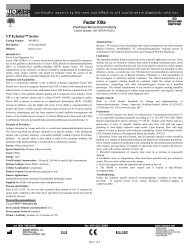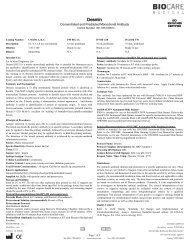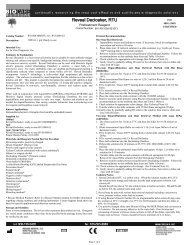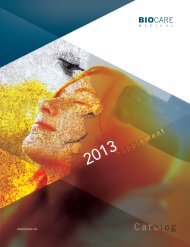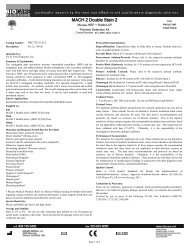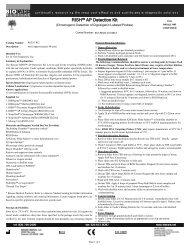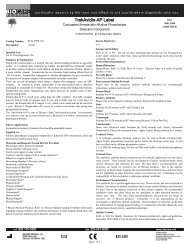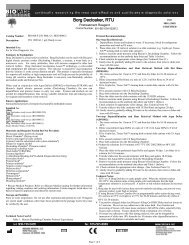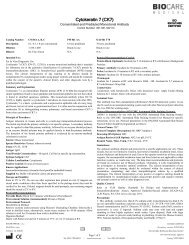Placental Alkaline Phosphatase (PLAP)
Placental Alkaline Phosphatase (PLAP)
Placental Alkaline Phosphatase (PLAP)
Create successful ePaper yourself
Turn your PDF publications into a flip-book with our unique Google optimized e-Paper software.
<strong>Placental</strong> <strong>Alkaline</strong> <strong>Phosphatase</strong> (<strong>PLAP</strong>)<br />
Concentrated and Prediluted Rabbit Monoclonal Antibody<br />
Control Number: 901-350-052112<br />
ISO<br />
9001&13485<br />
CERTIFIED<br />
Catalog Number: CRM 350 A, C PRM 350 AA<br />
Description: 0.1, 1.0 ml, concentrated<br />
6.0 ml, prediluted<br />
Dilution: 1:300-1:600 Ready-to-use<br />
Diluent: Van Gogh Yellow N/A<br />
Intended Use:<br />
For In Vitro Diagnostic Use<br />
Summary and Explanation:<br />
Rabbit monoclonal (<strong>PLAP</strong>) reacts with a membrane-bound isoenzyme (Regan and<br />
Nagao type) of <strong>Placental</strong> <strong>Alkaline</strong> <strong>Phosphatase</strong> occurring in the placenta during the 3rd<br />
trimester of gestation. This antibody is highly specific to <strong>PLAP</strong> and shows no crossreaction<br />
with other isoenzymes of alkaline phosphatases. It is useful in the<br />
identification of testicular germ cell tumors. Unlike germ cell tumors, <strong>PLAP</strong>-positive<br />
somatic cell tumors uniformly express epithelial membrane antigen (EMA).<br />
Principle of Procedure:<br />
Antigen detection in tissues and cells is a multi-step immunohistochemical process.<br />
The initial step binds the primary antibody to its specific epitope. After labeling the<br />
antigen with a primary antibody, an enzyme labeled polymer is added to bind to the<br />
primary antibody. The detection of the bound antibody is evidenced by a colorimetric<br />
reaction.<br />
Source: Rabbit Monoclonal<br />
Species Reactivity: Human; others not tested<br />
Clone: SP15<br />
Isotype: Rabbit IgG<br />
Total Protein Concentration: ~10 mg/ml. Call for lot specific Ig concentration.<br />
Epitope/Antigen: <strong>Placental</strong> <strong>Alkaline</strong> <strong>Phosphatase</strong> (<strong>PLAP</strong>)<br />
Cellular Localization: Cell membrane<br />
Positive Control: Placenta or seminoma<br />
Normal Tissue: Placenta<br />
Abnormal Tissue: Seminoma<br />
Known Applications:<br />
Immunohistochemistry (formalin-fixed paraffin-embedded tissues)<br />
Supplied As: Buffer with protein carrier and preservative.<br />
Storage and Stability:<br />
Store at 2ºC to 8ºC. Do not use after expiration date printed on vial. If reagents are<br />
stored under conditions other than those specified in the package insert, they must be<br />
verified by the user. Diluted reagents should be used promptly; any remaining reagent<br />
should be stored at 2ºC to 8ºC.<br />
Protocol Recommendations:<br />
Peroxide Block:<br />
Block for 5 minutes with Biocare's Peroxidazed 1.<br />
Pretreatment Solution (recommended): Diva<br />
Pretreatment Protocol:<br />
Heat Retrieval Method:<br />
Retrieve sections under pressure using Biocare's Decloaking Chamber, followed by a<br />
wash in distilled water; alternatively, steam tissue sections for 45-60 minutes. Allow<br />
solution to cool for 10 minutes then wash in distilled water.<br />
Protein Block (Optional): Incubate for 5-10 minutes at RT with Biocare's Background<br />
Punisher.<br />
Primary Antibody: Incubate for 30 minutes at RT.<br />
Protocol Recommendations Cont'd:<br />
Probe: N/A<br />
Polymer: Incubate for 30 minutes at RT with a polymer.<br />
Chromogen:<br />
Incubate for 5 minutes at RT when using Biocare's DAB - OR - Incubate for 5-7<br />
minutes at RT when using Biocare's Warp Red.<br />
Counterstain:<br />
Counterstain with hematoxylin. Rinse with deionized water. Apply Tacha's Bluing<br />
Solution for 1 minute. Rinse with deionized water.<br />
Technical Note:<br />
This antibody has been standardized with Biocare's MACH 2 detection system. It can<br />
also be used on an automated staining system and with other Biocare polymer detection<br />
kits. Use TBS buffer for washing steps.<br />
Performance Characteristics:<br />
The optimum antibody dilution and protocols for a specific application can vary. These<br />
include, but are not limited to: fixation, heat-retrieval method, incubation times, tissue<br />
section thickness and detection kit used. Due to the superior sensitivity of these unique<br />
reagents, the recommended incubation times and titers listed are not applicable to other<br />
detection systems, as results may vary. The data sheet recommendations and protocols<br />
are based on exclusive use of Biocare products. Ultimately, it is the responsibility of<br />
the investigator to determine optimal conditions. These products are tools that can be<br />
used for interpretation of morphological findings in conjunction with other diagnostic<br />
tests and pertinent clinical data by a qualified pathologist.<br />
Quality Control:<br />
Refer to CLSI Quality Standards for Design and Implementation of<br />
Immunohistochemistry Assays; Approved Guideline-Second edition (I/LA28-A2).<br />
CLSI Wayne, PA, USA (www.clsi.org). 2011<br />
Precautions:<br />
This antibody contains less than 0.1% sodium azide. Concentrations less than 0.1% are<br />
not reportable hazardous materials according to U.S. 29 CFR 1910.1200, OSHA<br />
Hazard communication and EC Directive 91/155/EC.<br />
Sodium azide (NaN 3 ) used as a preservative is toxic if ingested. Sodium azide may<br />
react with lead and copper plumbing to form highly explosive metal azides. Upon<br />
disposal, flush with large volumes of water to prevent azide build-up in plumbing.<br />
(Center for Disease Control, 1976, National Institute of Occupational Safety and<br />
Health, 1976)<br />
Specimens, before and after fixation, and all materials exposed to them should be<br />
handled as if capable of transmitting infection and disposed of with proper precautions.<br />
Never pipette reagents by mouth and avoid contacting the skin and mucous membranes<br />
with reagents and specimens. If reagents or specimens come in contact with sensitive<br />
areas, wash with copious amounts of water.<br />
Microbial contamination of reagents may result in an increase in nonspecific staining.<br />
Incubation times or temperatures other than those specified may give erroneous results.<br />
The user must validate any such change. The MSDS is available upon request and is<br />
located at http://biocare.net/support/msds/.<br />
Troubleshooting:<br />
Follow the antibody specific protocol recommendations according to data sheet<br />
provided. If atypical results occur, contact Biocare's Technical Support at<br />
1-800-542-2002.<br />
Limitations and Warranty:<br />
There are no warranties, expressed or implied, which extend beyond this description.<br />
Biocare is not liable for property damage, personal injury, or economic loss caused by<br />
this product.<br />
Page 1 of 2
<strong>Placental</strong> <strong>Alkaline</strong> <strong>Phosphatase</strong> (<strong>PLAP</strong>)<br />
Concentrated and Prediluted Rabbit Monoclonal Antibody<br />
Control Number: 901-350-052112<br />
ISO<br />
9001&13485<br />
CERTIFIED<br />
References:<br />
1. VI Shaw, et al. Utility of a selective immunohistochemical (IHC) panel in the<br />
detection of Components of mixed germ-cell tumors (GCT) of testis. United States and<br />
Canadian Academy of Pathology. Abstract #550. Annual Meeting, 1998.<br />
2. Suster S, et al. Germ cell tumors of the mediastinum and testis: a comparative<br />
immunohistochemical study of 120 cases. Hum Pathol 1998 Jul;29(7):737-42.<br />
3. Bailey D, et al. Immunohistochemical staining of germ cell tumors and intratubularmalignant<br />
germ cells of the testis using antibody to placental alkaline<br />
phosphatase and a monoclonal anti-seminoma antibody. Mod Pathol 1991. Mar;4<br />
(2):167-71.<br />
4. Burke AP, Mostofi FK. <strong>Placental</strong> alkaline phosphatase immunohistochemistry of<br />
intratubular malignant germ cells and associated testicular germ cell tumors. Hum<br />
Pathol 1988 Jun;19(6):663-70.<br />
5. Center for Disease Control Manual. Guide: Safety Management, NO. CDC-22,<br />
Atlanta, GA. April 30, 1976 "Decontamination of Laboratory Sink Drains to Remove<br />
Azide Salts."<br />
6. Clinical and Laboratory Standards Institute (CLSI). Protection of Laboratory<br />
workers from occupationally Acquired Infections; Approved guideline-Third Edition<br />
CLSI document M29-A3 Wayne, PA 2005.<br />
Page 2 of 2



